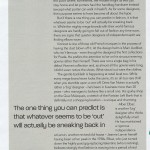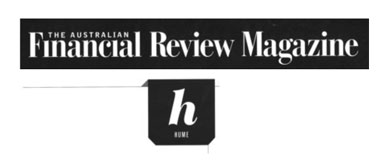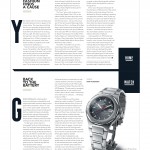Homage to the Seventies – AUSTRALIAN FINANCIAL REVIEW
The AFR Magazine December 2010
Story by Marion Hume
What is old is new again, and the advantage for me, racking up fashion years (which multiply at twice the speed of dog years, by the way) is that I’ve been round this circuit before. What’s the biggest trend right now? The seventies. Where did my fashion consciousness awake? Bliss was it in that dawn to be alive and wearing leg warmers.
In the 1980s, some fashion wag dubbed the ‘70s, “the decade that style forgot”, which stuck, although it was wrong. In fact, the ‘70s were rich and diverse. In just ten years, I dressed my teens through hippy, glam rock, disco, punk and then, at last came chic, as captured with the ultimate ‘70s movie “American Gigolo” (it came out in 1980, but it was made in 1978).
Paul Schrader’s movie, which opens with a scene that succeeds in making even the Los Angeles freeway look glorious, wasn’t a hit in Kyoto, Japan or, if it was, Akira Isogawa – who despite still looking annoyingly youthful was very much alive in the ‘70s – managed to miss it. So, on his recent trip to London, I felt duty-bound to re-rig the video recorder (how clever to have kept that hidden away) and soon we were listening to the soundtrack by Giorgio Moroder and I was trying quite hard not to sing along to Blondie’s “Call Me”.
Much has been made of the scene in which Richard Gere prances around like a latter-day dandy (or, to be accurate, just like the male hooker of the title role), matching “griege” shirts with beige ties as if that were hard.
This is the fashion world’s no. 1. favourite movie clip and certainly, I will never forget watching it WITH Richard Gere (gray around the temples, even more handsome) at the Giorgio Armani retrospective at the Guggenheim in New York a few years’ ago. When I say I watched it with Gere, there were only four people in a room at the museum in which the high points of Armani’s movie successes were being projected on a vast screen. Alas, I must concede that Gere is unlikely to reminisce about me being there, but watching him watch himself was a thrill all the same.
But I realised, re-watching the celebrated scene with Isogawa instead that the familiar version has actually being clipped; this to omit the opening where Gere scrapes his finger through a mountain of cocaine and rubs it vigorously into his gums before he begins the Herculean task of working out what he’s going to wear. Since 1978, there have been moments at Armani shows when a little lift would not have gone amiss, but despite all you hear about us drug-addled fashionistas, I’ve never seen anyone go that far since.
While Gere gets the glory, actually, it is Lauren Hutton who fascinates in the movie now. Hutton began the ‘70s as both gap-toothed girl next door and the world’s first supermodel and ended them (lucky her) kissing Gere and wearing satin blouses which look so utterly “now”. While Gere’s outfits changed menswear in what was then the future (think of a Hollywood agent in the ‘80s and you’ll imagine him wearing a beige Armani suit), Hutton’s outfits were a sartorial lament to a softness that was already disappearing and has taken 30 years to return. In between, womenswear has had a harder edge, starting with the “me me me” styles of the ’80s.
Why is softness back? It’s partly due to the achievements of a band of women who prefered dungarees when Hutton was wearing grey silk and who manned the barricades to fight for the equality we all now enjoy by law. Today’s designers – many of them women – are, largely, the first generation to be the children of working mothers and they are working mothers themselves.
Hence the 70s looks at Celine, Chloe, McCartney. But who I wonder, is going to reissue the fabulous soft trench coat Hutton slips off in the movie? We’ll have to wait for next season’s shows for that.
Dream Team – Financial Times
What to give the fashion person who has everything? Say you were Italian designer Domenico Dolce wondering what to buy for Stefano Gabbana, for example, or Gabbana wondering what to give Dolce, who already has a yacht. Where might you start?
The growing trend among fashion powers looking for the ultimate trinket is to search for something sporty. We’re not talking a fleece hoodie; we’re talking a team.
To wit: Dolce & Gabbana recently treated each other to 15 muscular men in satin shorts otherwise known as an Italian boxing team that competes on the WSB international circuit and will henceforth be called Dolce & Gabbana Milano Thunder.
“For the first time, a sporting team will carry our name. This is the beginning of a new adventure for us,” say the designers, neither of whom boxes. Of course, the team will also get a snazzy new kit.
This is not a sporting first for the designers. Dolce & Gabbana has a three-year agreement with Chelsea FC to kit out Ashley Cole, Frank Lampard and the rest of the squad with official suits, and has created the “Dolce & Gabbana Lounge” in the West Stand at Stamford Bridge. It is more stylistically flashy than it was in its previous incarnation as “the Armani Lounge”, as that earlier sponsor filled the space with muted pieces from the Armani Casa range.
Giorgio Armani was not the first fashion designer to see the literal appeal of the physical – Jean Patou dressed Suzanne Lenglen, a glamorous French tennis star, in the 1920s – but it was Armani who mined the marketing relationship between style and sport, starting in 1995, when he declared footballers “today’s new style leaders” and invited David James, then Liverpool goalkeeper, both on to the catwalk and into his Emporio Armani underwear advertisements. Other players, notably David Beckham and Cristiano Ronaldo, have joined Team Armani since, the latest in the posse being tennis world number one Rafael Nadal. Armani also owns Armani Jeans Milano basketball team.
Which is why it would be such a struggle if you drew him as your “Secret Santa” recipient; ditto Diego della Valle, Tod’s chief, who already owns the Italian football team Fiorentina. And what on earth would one buy Sergio and Pier Luigi Loro Piana of the eponymous brand? They’ve already treated themselves to a polo team. (Surprisingly, the Polo man himself, Ralph Lauren, does not have a team of his own, though instead he sponsors the Black Watch team captained by Argentine international and Ralph Lauren model Ignacio Figueras).
Meanwhile, Hermès launched a show-jumping competition, the Saut d’Hermès, at Grand Palais in Paris in April, and Zegna has its own ski resort.
Look deeper and it’s hard to find a designer not involved with sport. Emilio Pucci was an Olympic skier before he created his own line, which includes skiwear; Paul Smith, who sells bikes as well as suits, was a boy racer at the Beeston Road Club in Nottingham. Stella McCartney is charged with designing Britain’s look for the the 2012 Olympics, and Donna Karan has a long-term sponsorship arrangement with baseball’s New York Yankees.
“The marriage is natural,” says Karan. “DKNY and Yankee Stadium are quintessentially New York in spirit. Both are a part of our culture, our streets, our collective consciousness.”
Hugo Boss, however, is the company that has basketball sewn up, working with the Knicks so that during games at Madison Square Gardens, interactive voting is tallied up on the huge screens in categories such as “best-dressed fan”. Boss is involved in so many sports – from golf to tennis to sailing to soccer – that it’s hard to keep track. “And don’t forget we’ve been the sponsor of McLaren at Formula One for 30 years,” says Philipp Wolff, senior vice-president.
So what’s in it for them, besides love? Ketty Maisonrouge of Columbia Business School and president and co-founder of the Luxury Education Foundation explains: “The sports teams selected by the fashion houses are increasingly appealing to men, which follows the movement of a certain masculinisation of fashion, as fashion houses go after this historically less-tapped market. Men feel more confident caring about themselves and their appearance, and fashion brands want to make men even more comfortable with this interest by selecting sports teams that are considered highly masculine.”
Thus even brands where you think “No, never” have been bitten by the sports bug. The late Franco Moschino, who died in 1994, was a joker, not a jock. Yet which brand has just signed a deal with Aironi, the Italian rugby team formed to take part in this year’s Magners League and Heineken Cup? You guessed it.
“I’m proud that a rugby team chose Moschino to dress its image around the globe,” says Rossella Jardini, Moschino creative director. Consider it their gift to the brand.



